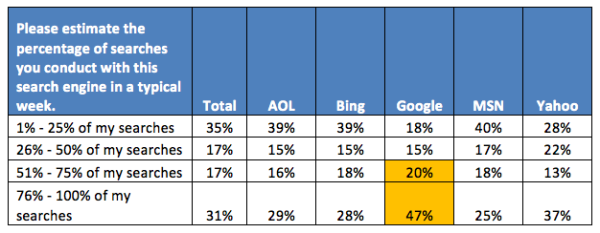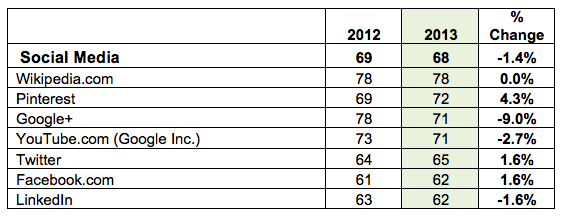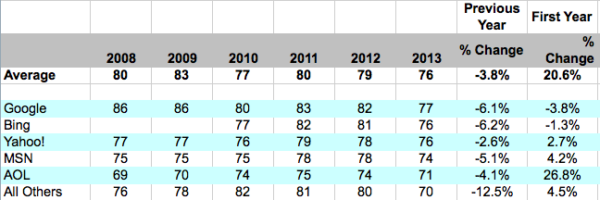There’s a mystery surrounding the latest customer satisfaction numbers released by ForeSee Results (for the American Customer Satisfaction Index [ACSI]). Published late last night, they indicate the lowest levels of consumer satisfaction with search engines (and portals) since 2003.
The satisfaction scores for social sites are worse.
According to the survey, which ranks sites on a 100 point scale, Google received its worst score (77) since the inception of the survey more than a decade ago. Google’s score last year was 82. This year Bing and Yahoo both received scores of 76, which are lower than in 2012 as well. The category average was 76. AOL fared worst with a 71 score.

Source: ForSee Results/ACSI (2013)
The explanation offered for the low scores is that “advertising is diminishing the customer experience, especially among search engines.” ForeSee juxtaposes advertising and the customer experience. But this doesn’t entirely make sense in the context of search advertising, unless there’s been a marked decline in the relevance of search ads (or a marked increase in the number of ads on the page).
According to the survey, “22 percent of search engine visitors cited advertisements as what they liked least about the site.”
ForSee results and the ACSI assert that these satisfaction scores are predictive of future consumer behavior and market share. While that may be true for traditional industries and brands, that logic has not played out in the e-business category. Past gains by search engines other than Google have not translated into market share gains. And since there was a decline in the 2013 scores across the board we can similarly expect little or no change in market share resulting from these scores.

Source: ForSee Results/ACSI (2013)
One of the more interesting findings of the survey concerns search loyalty. Those using sites other than Google as primary search engines saw a decline in 2013. This may well be the most significant search-related finding of the survey:
The number of people who use Google exclusively for search has stayed consistent, while the proportion of exclusive users of other search engines has declined since last year. Search engines not named Google experienced an average drop of 30% in primary users (those who identify the site as their primary search engine). Google dropped only 6%. Still, it seems that consumers are shopping around for search more than they have in the past.
ForeSee found that satisfaction scores for social media sites were even lower than search engines. Indeed the company said, “The category scores dropped a point to 68, putting social media on par with airlines, and rating better than only subscription TV service and ISPs.”

Source: ForSee Results/ACSI (2013)
Google+ had higher satisfaction scores than Twitter and Facebook, which both saw slight gains vs. last year. However Google+ experienced a massive satisfaction decline compared with its 2012 scores. In this category, two satisfaction scores have not translated into usage gains or losses historically. Pinterest saw the biggest gains of the category, improving from a 69 to a 72 in 2013.
Perhaps the source of the thesis that ads are driving down satisfaction scores, ForeSee found that large numbers of users on social media sites simply ignore ads or find them annoying. In the chart below, majorities of survey respondents said they “don’t pay attention” to ads on these sites — the average was 60 percent across the category.

Source: ForSee Results/ACSI (2013)
Among all the social sites in the survey users seemed to notice or pay attention to ads on Google+ most and least on LinkedIn. In addition, 27 percent of Facebook user-respondents said that ads “interfere with my experience” on the site. But because there’s no historical data we can’t evaluate whether the numbers are improving or getting worse.
The big and rather bland takeaway from these e-business satisfactions scores is that site owners and publishers must pay constant attention to user satisfaction and should make ads as relevant and engaging as possible.
The ACSI was created by the University of Michigan but ForSee Results administers the “e-business” component of the index.
Postscript: Below are the ACSI search satisfaction scores essentially since measurement began and for the past five years. There were no scores for Bing until 2010.










